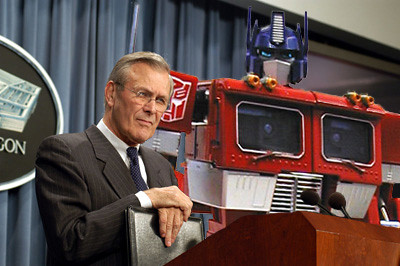Here is the revolution in military affairs and defense transformation in 500 words. It earned me an A in my defense policy class at GWU:
War is a dynamic enterprise that centered around one goal: Control over the production of goods. Agrarian societies fought over arable territory. Industrial societies fought over natural resources and population centers. Post-industrial societies today fight over ideas, information and technology.The methods of fighting war have also shifted to meet these changes in the means of production. Seasonal peasant armies armed with bows and triremes gave way to conscripted riflemen and ships-of-the-line around the 16th Century. These modes of combat themselves gave way to armor, airplanes, radio, submarines and the combined arms assault in the 20th Century.

These macro-historic changes have been labeled revolutions in military affairs (RMA) and many historians believe they have played a significant role in world history. The DOD became aware of RMA in the 1980s when Soviet military thinkers began to study eras of fundamental transformation in warfare. It is this narrower focus on the impact of small-scale technological and tactical changes evolved into the term defense transformation.
The 2003 Defense Transformation Guidance defines transformation as “a process that shapes the changing nature of military competition and cooperation through new combinations of concepts, capabilities, people and organizations that exploit our nation's advantages and protect against our asymmetric vulnerabilities to sustain our strategic position, which helps underpin peace and stability in the world.”
In order to achieve this ‘shaping,’ the DOD has drafted policies intended to array its finite resources against a range of unknowable future threats and vulnerabilities. These policies are designed to balance current and future-spending priorities and competing needs for basic research and system development while avoiding the tendency for path-dependency caused investment in technology.
The advantage of this approach is that it does not commit the DOD to one transformation strategy. It allows for both small, ‘evolutionary’ steps and large, ‘revolutionary’ leaps in military capabilities.
Unfortunately, this approach is also fraught problems. Splitting resources between revolution and evolutionary efforts may yield a military that is a jack-of-all-trades, but master of none. Transforming to maintain a preponderance of power may encourage adversaries to pursue the means to counter maturing U.S. capabilities, creating the technological equivalent of a “self-fulfilling prophecy.”
Two other criticisms can leveled at defense transformation as well. First is that transformation cannot be pursued in a socio-political vacuum. Social norms and political organizations have placed limitations on the ways in which militaries have been mustered, equipped and used for centuries. There is no reason to Western democracy doesn’t share this tendency.
The second is that transformation policy creates the mentality that change can be actively fostered through political or bureaucratic intervention. Defense transformation only a small part of sweeping social, economic and political change caused by shifts in the means of production. It would be more effective to focus on reducing the factors that prevent endogenous transformation, such as bureaucratic aversions to risk and change.

1 comment:
Good summary. You did a good job at distilling the essence of a complex topic.
Post a Comment